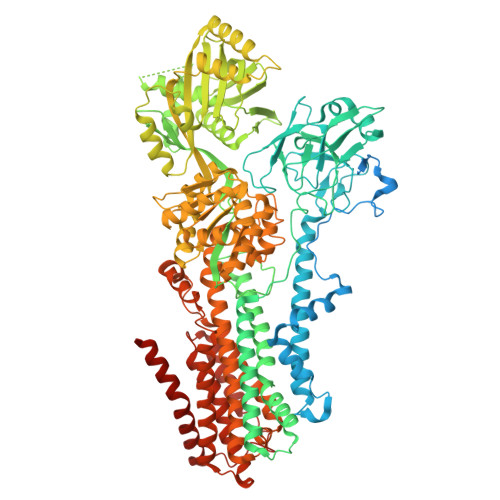P4-ATPase control over phosphoinositide membrane asymmetry and neomycin resistance.
Jain, B.K., Duan, H.D., Valentine, C., Samiha, A., Li, H., Graham, T.R.(2025) bioRxiv
- PubMed: 40093091
- DOI: https://doi.org/10.1101/2025.03.03.641220
- Primary Citation of Related Structures:
9BS1 - PubMed Abstract:
Neomycin, an aminoglycoside antibiotic, has robust antibacterial properties, yet its clinical utility is curtailed by its nephrotoxicity and ototoxicity. The mechanism by which the polycationic neomycin enters specific eukaryotic cell types remains poorly understood. In budding yeast, NEO1 is required for neomycin resistance and encodes a phospholipid flippase that establishes membrane asymmetry. Here, we show that mutations altering Neo1 substrate recognition cause neomycin hypersensitivity by exposing phosphatidylinositol-4-phosphate (PI4P) in the plasma membrane extracellular leaflet. Human cells also expose extracellular PI4P upon knockdown of ATP9A, a Neo1 ortholog and ATP9A expression level correlates to neomycin sensitivity. In yeast, the extracellular PI4P is initially produced in the cytosolic leaflet of the plasma membrane and then delivered by Osh6-dependent nonvesicular transport to the endoplasmic reticulum (ER). Here, a portion of PI4P escapes degradation by the Sac1 phosphatase by entering the ER lumenal leaflet. COPII vesicles transport lumenal PI4P to the Golgi where Neo1 flips this substrate back to the cytosolic leaflet. Cryo-EM reveals that PI4P binds Neo1 within the substrate translocation pathway. Loss of Neo1 activity in the Golgi allows secretion of extracellular PI4P, which serves as a neomycin receptor and facilitates its endocytic uptake. These findings unveil novel mechanisms of aminoglycoside sensitivity and phosphoinositide homeostasis, with important implications for signaling by extracellular phosphoinositides.
Organizational Affiliation:
Department of Biological Sciences, Vanderbilt University, Nashville, TN, USA.
















